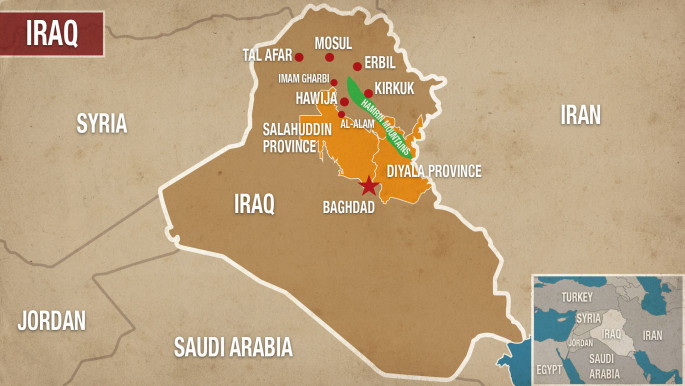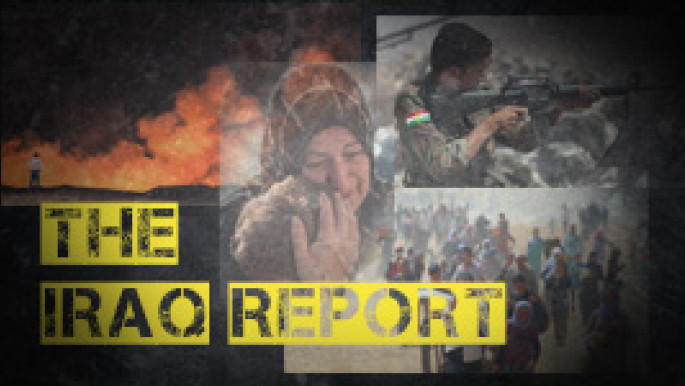The Iraq Report: IS reduced to final bastions in Iraq
Click here to receive The Iraq Report each week in your inbox
As the Islamic State group loses more and more territory in Iraq, hopes have been raised that the extremists will be living their last days in the war-ravaged country, with other defeats farther afield in Syria heralding a potential collapse in the group’s ability to wage war. However, and although IS’ fighting power has been reduced in the conventional sense, there are lingering fears that the group is instead modifying its strategy and readying its fighters for a protracted confrontation.
However, while IS is certainly the most high-profile of Iraq’s problems, it is not by any means the only issue facing the country. The core issues that led to IS finding fertile ground for their operations have yet to be addressed and are instead being intensified. Growing sectarianism, fuelled by foreign powers, has left Iraq’s international relations stumbling over curtailing the influence of Iranian proxies in Iraq.
IS lose Hawija, lurk on Iraq-Syria border
Last Thursday, the Iraqi military declared victory in IS’ last northern stronghold, in a move touted as the latest sign that the group’s days in Iraq were well and truly numbered. Iraqi army units and allied Shia Islamist militants from the Popular Mobilisation Forces – an Iran-backed but Iraq-sanctioned paramilitary organisation – began to move in on Hawija the day before victory was claimed.
However, there are concerns that recapturing Hawija was simply “too easy”. While there can be no doubt that major battles such as the fight for Mosul were costly for IS, recent analysis indicates that the militants have been discussing how to modify their strategy, and how to learn from mistakes that cost them dearly in terms of manpower and materiel.
 |
According to the IS newsletter, Al Naba, the group learned from their operations in Syria, and these learnings will doubtless be applied across the border in Iraq. One of the main issues faced by IS fighters is the destructive capabilities of the US-led coalition’s airpower, which has devastated their ranks over the years. IS has discussed ways of mitigating overwhelming air support for ground units supported by the United States and other actors.
These combat lessons may well have been applied in Hawija, which is very near the Hamrin mountains. It is thought that the reason why Hawija fell in a day is simply because IS militants withdrew to the mountains, preferring to live to fight another day rather than dying in a bloody fight to the bitter-end against overwhelming odds. The meatgrinder of Mosul in Iraq and Kobane in Syria had an indelible impact on IS’ strategic thinking.
According to comments on Saturday by the deputy commander of the US-led coalition, Brigadier General Robert Sofge, the “final large fight” with IS will likely take place on the Iraqi-Syrian border. While it remains to be seen whether IS will put up stiffer resistance in the area around Qaim, Ana and Rawa near the Syrian border than they did in Hawija and Tal Afar, recent experience suggests the militants will attempt to thin out incoming forces as much as possible as they approach, before withdrawing through well-planned escape routes.
 |
|
| Catch up with our weekly round-up from Iraq |
Tal Afar ethnically cleansed of Sunnis
Even should the Iraqi government and the US-led coalition be successful in defeating IS in Iraq, it seems doubtful they will see long-term results due to the human rights abuses and sectarian atrocities being committed by Iraqi forces.
According to a report published by Middle East Eye on Tuesday, the Turkmen-majority city of Tal Afar – about 80 kilometres west of Mosul – has been reduced to a ghost town where Shia extremist militias roam the streets and houses belonging to Sunni civilians are torched in sectarian revenge attacks.
Like many Iraqi towns and cities, Tal Afar was captured by IS in 2014 and was recaptured by the Iraqi military in August after only a short fight. Since then, buildings around the city’s central citadel lie largely empty and homes belonging to Sunnis are reportedly being destroyed by the PMF – also known as the Hashd al-Sha’abi in Arabic – supposedly to prevent their owners from returning to the city and in order to effect a major demographic change.
The report quoted a Tal Afar resident, Bassam Abdullah, who had fled to nearby Mosul as he felt it safer than his hometown. Abdullah said that his cousin, a Tal Afar municipal worker, had been ordered back to the city to begin restoring public services. His cousin then reported that, “the Hashd are burning some houses. They are burning Sunni homes. The Shia houses they leave alone”. Many of these homes had already been pillaged by Shia Islamist militants loyal to Tehran.
The report reflects a continuation of sectarian abuses and ethnic cleansing campaigns that have been extensively documented by Human Rights Watch, Amnesty International, as well as media organisations, including The New Arab. In May, The New Arab’s Arabic sister site reported a number of abuses occurring in Mosul, including the arbitrary detention of women accused of being related to IS fighters. Atrocities – including torture, murder, and rape – were reported by numerous outlets and human rights organisations throughout the fight for Mosul.
 |
| Pipelines outside Hawija lead to an oil field set ablaze by retreating Islamic State group fighters [AFP] |
Saudi-Iraqi rapprochement stumbles
Iranian proxies and their activities in Iraq and beyond have not only caused concern for human rights organisations, but also to neighbouring states seeking to assert their influence in Iraq.
In August, Saudi Arabia extended a hand to Shia firebrand cleric and militant leader Muqtada al-Sadr in an attempt to woo him away from Iran’s orbit. This move was seen as controversial by many of Iraq’s Sunni Arabs, who were the main victims of Sadr’s sectarian militia violence. Sadr received arms, money and training from Iran, although his disputes with another divisive Shia Islamist politician and vice president, Nouri al-Maliki, have caused him to occasionally fall foul of Tehran’s ire.
Sadr’s visit was swiftly followed by Saudi announcements that it would open up new diplomatic missions in major Shia holy cities such as Najaf; also the reopening of the border between the two Arab nations in August for the first time in 27 years.
However, and since these significant steps, Riyadh has toned down its rhetoric regarding its rebuilding of ties with Baghdad, and efforts have either gone under the radar, or have been significantly curtailed. This is likely due to the lack of political gravity Saudi Arabia has compared with Iran, which has had decades to build relations and influence with Iraqi political movements, particularly Shia Islamists in exile during Saddam Hussein’s rule. On the other hand, Saudi Arabia made no such efforts, or when it did, it only did so in tandem with the United States, such as supporting secular Shia politician Ayad Allawi during elections in 2014.
The modern Iraqi political picture is dominated by dozens of not only Iran-backed parties, but Iran-incubated groups who owe their entire existence to Tehran, as well as their current positions of influence and power. The Badr Organisation, for example, was formed early in the Iran-Iraq War in the 1980s, and was not only trained by Iran to fight against the Iraqi army, but is ideologically in thrall to the ayatollah regime. Such bonds of wealth, influence, and spirituality are hard to break, and Saudi Arabia will have its work cut out for it if it aims to disrupt these decades-old relationships.
Click here to receive The Iraq Report each week in your inbox
Follow us on Twitter: @The_NewArab





 Follow the Middle East's top stories in English at The New Arab on Google News
Follow the Middle East's top stories in English at The New Arab on Google News


